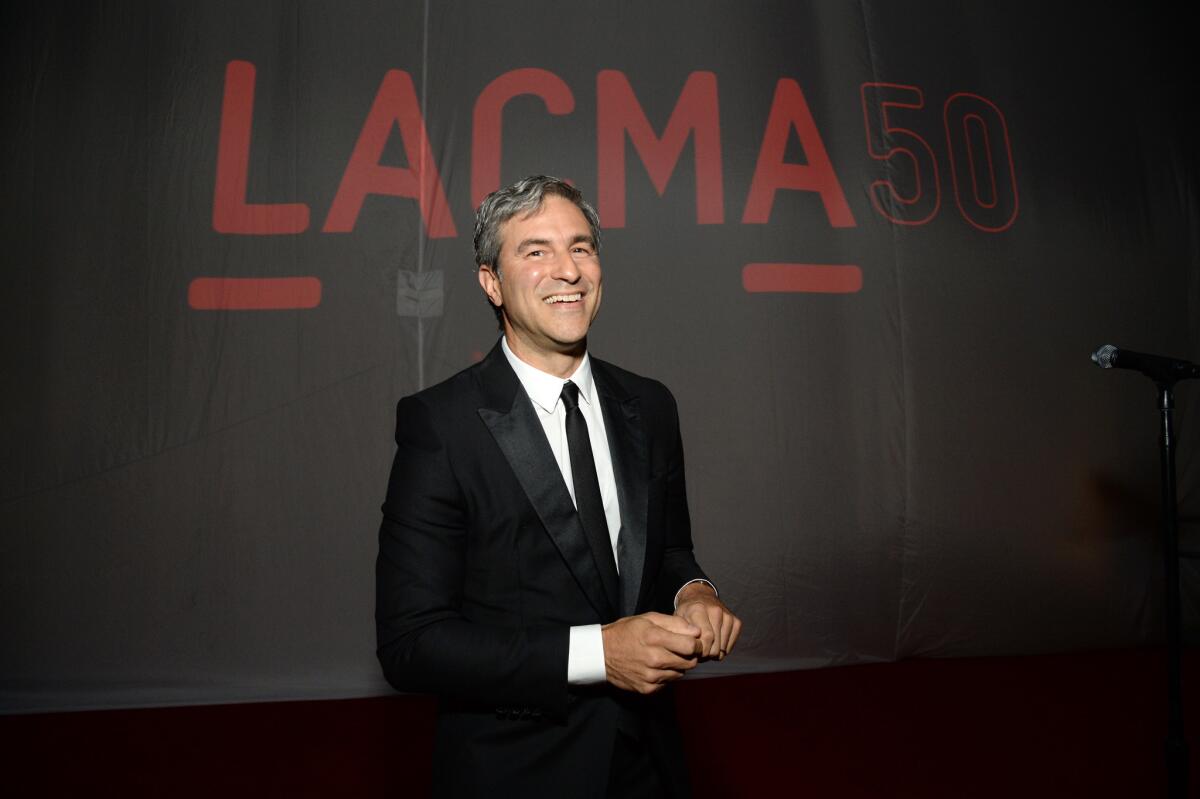Op-Ed: Will L.A. County give its art the space it’s due?

- Share via
In a prelude to its 50th anniversary celebration, the Los Angeles County Museum of Art released Swiss architect Peter Zumthor’s most recent plan to expand the museum at the end of March. County money has been earmarked, and there’s a sense that LACMA may finally deliver on its decades-old dream to remake its campus.
Still, it’s early in the design process, and there’s time to ask whether what LACMA is planning is what the museum really needs. That’s a crucial question, given that the face-lift will require what is probably a once-in-a-generation fundraising campaign to meet the building’s estimated $650-million price, and perhaps millions more.
LACMA presents the Zumthor design as a necessary replacement of three drab buildings designed by William Pereira, plus the museum’s entrance pavilion and uninspired Art of the Americas building, by Hardy Holzman Pfeiffer. The Zumthor plan calls for an amoeba-like structure that re-imagines LACMA’s campus and its place in the city.
Those are worthy goals. The old buildings are for the most part dark, soulless shoe boxes that warehouse art rather than showcase it meaningfully as cultural history. They are also energy hogs, and they need about $300 million (according to two estimates) in seismic and safety upgrades.
All those practicalities argue for tear-down, but they don’t answer the most important question. What will Zumthor’s plan do for the museum’s art and its audience? An art museum presents our histories in visual form; is LACMA making room for enough stories?
The museum says the Zumthor design will provide about 160,000 square feet of gallery space. There are 120,000 in the structures slated for demolition, which means the museum will gain 40,000 square feet of galleries.
Michael Govan, LACMA’s director, told me 40,000 square feet was about the increase the museum’s current staff could handle. Museums typically determine how much gallery space to add in an expansion based on a planning process that involves curators and other stakeholders. Had LACMA done this? Govan said he updated an assessment of the museum’s needs prepared in 2001, when LACMA considered a new campus design by architect Rem Koolhaas. That means a 2001 study could inform a building LACMA hopes to open nearly a quarter-century later.
How much more space might LACMA need? There’s no calculation that dictates the right size for a museum. Instead, let’s consider what LACMA doesn’t have dedicated, permanent space for now, and how its peers who recently expanded handle that same material.
Los Angeles is one of the world’s four major centers of art production. Yet the museum has no permanent-collection galleries that tell a California-authored story of contemporary art. (Yes, the campus includes a building called the Broad Contemporary Art Museum at LACMA, but like the Resnick Pavilion, it is mostly used for temporary installations and exhibitions, not for displaying the permanent collection.)
Here’s how much space other encyclopedic museums reserve for contemporary art. The Cleveland Museum of Art, which opened an expansion in 2013, devotes 7,100 square feet to it. The Art Institute of Chicago debuted a wing in 2009 that includes about 23,000 square feet for contemporary art, plus another 9,000 square feet for related disciplines. Neither city is the art-making center that Los Angeles is.
LACMA also lacks dedicated space for photography. The San Francisco Museum of Modern Art plans 15,000 square feet for photography when it reopens after a remodel and expansion. LACMA’s photo collection isn’t as significant, but it has important holdings.
If LACMA were to keep up with Chicago for contemporary art, and use, say, half the space for photography that SFMOMA is setting aside, three-quarters of its added gallery space would be taken. And LACMA has 20 more collecting areas to consider, many of which — German Expressionism, Spanish Colonial art, Islamic art — arguably deserve more space than they now have at the museum.
The proposed Zumthor building is also awfully expensive given its modest gain in exhibition space. In 2009, the Art Institute spent $294 million for its 250,000 square feet addition, including 64,000 square feet of new gallery space. The next year, the Museum of Fine Arts, Boston got 30,000 square feet of additional galleries in a $345 million, 133,500-square-foot addition. Cleveland got about 60,000 new square feet of gallery and related space, as part of its 200,000-square-foot, $320-million 2013 project. LACMA will have to raise roughly double what these institutions spent — all for an additional 40,000 square feet of new galleries.
To LACMA’s credit, its design process has been unusually open. There is much that has yet to be nailed down in the plan, and there’s time for the museum to adjust its proposal. As the museum undertakes a signature project that could exhaust donors for a generation, it must be certain that it addresses a generation’s worth of needs.
Tyler Green is the producer and host of “The Modern Art Notes Podcast.” His book on artist Carleton Watkins will be published by University of California Press.
Follow the Opinion section on Twitter @latimesopinion and Facebook
More to Read
A cure for the common opinion
Get thought-provoking perspectives with our weekly newsletter.
You may occasionally receive promotional content from the Los Angeles Times.









